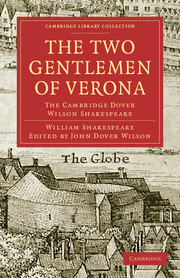THE COPY FOR THE TEXT OF 1623
Published online by Cambridge University Press: 07 September 2010
Summary
There is no Quarto for The Two Gentlemen and the play probably first saw the light of print in the First Folio. The most striking bibliographical features of this text, features which it shares with The Merry Wives, its successor in the Folio, are the complete absence of stage-directions and the almost complete absence of entries and exits for characters, except at the beginning or end of the scenes. Despite the claim in the Folio sub-title that the plays of that volume were ‘truely set forth, according to their first originall,’ it is hardly possible that a text in this condition can have been printed from theatrical prompt-copy, still less from the author's manuscript. No company could have acted the play as it stands. Yet it is not difficult to see how such a text could have been made up for a printer.
For stage-performances in Shakespeare's day three sorts of manuscript material were necessary. First, there was the prompt-copy, which contained at least the bare minimum of stage-directions together with precise indications for the entry of characters and generally, though being less important not so invariably, the indications for exit. Second, there were the players' parts, which were transcribed from the prompt-copy, with the cues, and handed out to the actors for the memorising of their lines. Third, there was the ‘plot’ or ‘plat’ of the play, a foolscap sheet (often pasted on to a board so that it could be hung up at a convenient place behind the scenes) on which were written the names of the characters appearing in each scene and of the actors playing them, in the order in which they were to come on.
- Type
- Chapter
- Information
- The Two Gentlemen of VeronaThe Cambridge Dover Wilson Shakespeare, pp. 77 - 82Publisher: Cambridge University PressPrint publication year: 2009First published in: 1921

